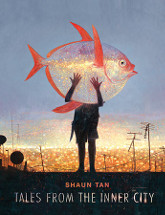Tales from the inner city by Shaun Tan

Allen and Unwin, 2018. ISBN 9781760523534
(Age: middle school to adult) Highly recommended. Themes: Design,
Cities, Animals. Twenty five stories about the relationship between
humans and animals is explored in this richly illustrated book from
Tan, a companion volume to Tales from Outer Suburbia (2008)
and one Tan has been working on ever since. Every page has something
startlingly new, making the reader pause and read again, then pore
over the illustrations, making sure they have absorbed every nuance,
before starting again.
His last chapter begins, "We tell each other the same story" but the
details of Shaun Tan's stories are entrancing. His sometimes
dystopian view of the city and its relationship with animals is
highly individual, placing animals in the oddest of settings:
crocodiles living on the eighty seventh floor, an eagle in an
airport, deer peering out of an office window, making us question.
One of the first sequences in the book, "Once we were strangers",
devotes forty pages to a dog, at first wary of the human with a
spear in one hand, but over time becoming a companion, ending as a
dog on a lead walking with its human. The illustrations reflect the
passage of time. The broad strip between the human and the dog
begins as a wide black expanse, the void of the early cosmos
perhaps, then it becomes a track, changing to a bridge, a railway
line, a road, and finally the double page is fully paved. Time has
passed, reflecting the changes in our environment as well as the
changed relationship between humans and animals.
Shaun Tan talks
about his work providing insight into his book as he provokes, prods
and perplexes his readers.
Each of his works in this volume initiates a response, the richly
illuminated and detailed images giving more as the reader looks,
ponders and talks about what they see. The almost poetic text forces
the reader to read it again, viewing the illustration with new
ideas, evaluating the links between the two.
People and animals may live in each other's shadow, but they are
still very visible in Tan's work, from the tiger strolling by the
similarly coloured wall on the last endpaper, or the rhino watching
over the traffic or the killer whale in the night sky.
Light in various forms is shown to advantage: city lights on the
front cover, the coloured light of the crowds of butterflies, the
light behind the snails on the bridge, the light pouring in through
the classroom windows, the light coming out of the high rise flats,
contrasting with the many dark and gloomy images redolent of a
dystopian landscape, stressing the tension within the city, leading
to the last page of the book with its apocalyptic image.
The inner city is shown in images of crumbling high rise buildings,
homeless people, train tracks, telegraph poles and animals, all
giving a different perspective than the one expected. The teacher in
the classroom is hugging a sheep, the boy on the cover holding a
glass fish, owl's eyes peer out at the reader from the hospital
ceiling, a bear is led up the steps, a shark rises up out of the
landscape, but unlike the lonely vistas of Jeffrey Smart's cities,
Tan's images of the concrete structures force the reader to
reevaluate the connection between human and beast.
I found this book totally captivating, sometimes unsure that I had
missed something, but always satisfied at the myriad of references,
allusions and journeys down unexpected pathways that Tan takes his
readers.
Teacher
notes can be found on the Allen and Unwin site.
Fran Knight